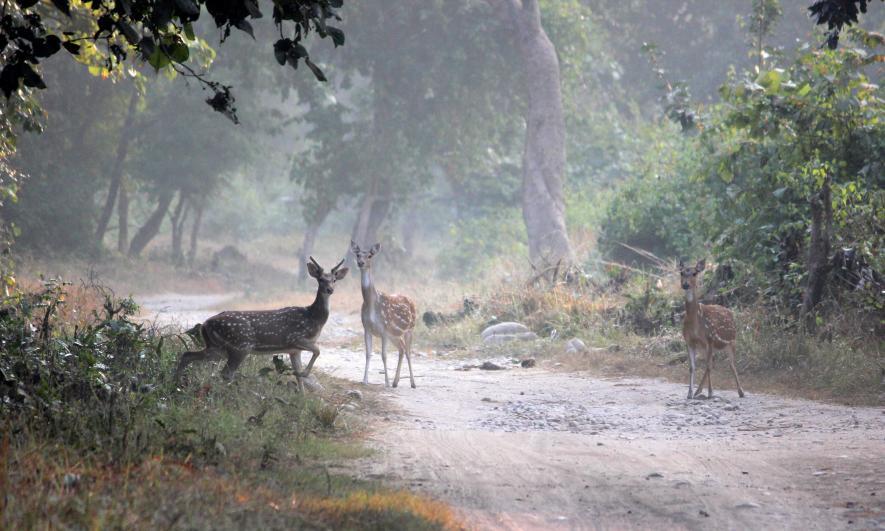How Uttarakhand Leaders Hurt the Fragile Ecology of their State

Deers in Jim Corbett National Park. Representational Image.
Once again, the Forest Minister of Uttarakhand Harak Singh Rawat has declared he is not interested in contesting in the 2022 Assembly election. The bigwigs in his party, the Bharatiya Janata Party, should take his statement at face value and ensure he does not get a ticket.
Over the last five years, each decision of the state forest ministry under his watch has been anti-forest, anti-river, and anti-wildlife. The frequency and intensity of natural disasters have alarmingly risen in the state. Rawat’s complete disregard for basic conservation principles leaves one bewildered. How could Prime Minister Narendra Modi declare at Glasgow that India is committed to safeguarding environmental norms when state governments flout every diktat spelt out in the rule-book?
Take the decision to allow roads to bifurcate two of Uttarakhand’s best-known wildlife sanctuaries, the Jim Corbett Tiger Reserve and the Rajaji National Park. The state forest department was the prime mover of the project to have a road cut across the Jim Corbett reserve, which has one of the few viable tiger populations in the country. The proposed route would have connected Ramnagar with Kotdwar, the minister’s electoral constituency. Thankfully, the Supreme Court shot down the project. It did not stop the minister from turning a blind eye to illegal constructions inside Corbett Park. The constructions allegedly diverted the Compensatory Afforestation and Planning Authority funds.
The National Tiger Conservation Authority has ordered the demolition of these unauthorised buildings, but how were they permitted in the first place? Now, these natural habitats have already been destroyed in the process of construction.
Again, it took a high powered committee and Supreme Court intervention to quash the Uttarakhand government’s proposal to build a road between Laldhang and Chillarkhal within the Rajaji National Park. The government was going through this construction without securing prior wildlife-related clearances. The state government still succeeded in partially getting its way and building a shorter stretch of road between Laldhang and Chillarkhal at the critical juncture where the Corbett Tiger Reserve connects with the Rajaji National Park.
The state government approached Union Defence Minister Rajnath Singh, telling him the road through Corbett was necessary for defence purposes, for it would connect the Garhwal Rifles headquarters to the Kumaon Regiment headquarters in Ranikhet. The state even sent a similar letter to the National Security Adviser Ajit Doval in this regard.
Citing defence and national security concerns is among the most convenient excuses to get past environmental rules. The Supreme Court has allowed the widening of the Chardham road to make it double-lane with paved shoulders, although experts say its construction has made the region disaster-prone. In the last three years, Uttarakhand has faced one killer landslide after another, with large road tracts shut for weeks on end. The clearance from the court has come on defence and security grounds despite scientists having warned otherwise.
The unkindest cut of all was the state government’s decision to denotify Uttarakhand’s only elephant reserve, the Shivalik Elephant Reserve, in 2020. It was to facilitate the expansion of the Jolly Grant Airport, although airport officials were reportedly willing to consider alternative sites.
The Shivalik Reserve is integral to the state’s forest divisions that extend across Dehradun, Haridwar, Lansdowne, Haldwani, Tanakpur and Ramnagar and include parts of the Corbett Reserve and Rajaji Park. Even the Union Ministry of Environment was taken aback by the incredible order denotifying this zone and shot off a letter saying the area proposed for diversion was of high conservation value and would fragment riverside forests.
The state’s chief wildlife warden Jaber Singh Suhag did not defend the elephant reserve. Instead, he said in January 2021, “Today, this is named an elephant reserve. Tomorrow some butterfly reserve will come up. In this way, no work can be done in Uttarakhand.” Dismissing concerns about the presence of an elephant corridor, Suhag blissfully added, “Elephants can pass from anywhere” and suggested building flyovers for unhindered movement of animals.
A forester with such a track record would get reprimanded, at the very least, in any country, but evidently not in Uttarakhand, India. It was left to the Uttarakhand High Court in March 2021 to stay the entire affair and ask, “How can protectors of nature perpetrate this kind of destruction?”
Yes indeed, how can they? As election frenzy peaks, hundreds of tractors are visible along the banks of the Ganga, carrying sand and stones. Although both the Congress and the BJP have promised to end sand mining on the Ganga, Yamuna and other rivers, no leaders, including Prime Minister Modi and Rahul Gandhi, who have addressed election rallies, have ever mentioned this. [The rumour in political circles is that Harak Singh Rawat wishes to return to the Congress party, which he had quit to join the BJP.]
We can gauge the extent of sand mining from some key bridges that have collapsed in the state due to excessive extraction. These include the crucial Rani Pokhari bridge connecting Dehra Dun to Rishikesh, a bridge on the Song river connecting Sahasradhara to Maldevta and the Haldwani bridge over the Gaula river, which collapsed on 9 October, costing the exchequer crores.
If these were not losses enough, surmise the greed and neglect of state politicians from a recent order permitting river bed mining. It will jeopardise the water resources of North India because several vital rivers emanate from the Himalayas. Presently, heavy machines are operating on these riverbeds, causing massive destruction.
Environmentalist Loveraj Singh has challenged the new sand mining policy through his PIL in the Uttarakhand High Court. Hearings are presently on, but residents living along the rivers are bitter about how mechanised mining destroys ecology.
Despite multiple strictures from the courts, the Uttarakhand government continues on its disastrous path. The state government and the National Highways Authority of India are pushing to construct a 30-km road and tunnel from Jolly Grant Airport to Koti Colony near the Tehri Dam. Chief Minister Pushkar Singh Dhami has sought approval for this double-lane tunnel, touted as the longest in the world. The government will prepare a Detailed Project Report, but the instability of the Himalayas, where there is a great deal of anthropogenic or human pollution-causing activity, is the big question mark.
Maybe because of court rebukes, Rawat decided the easiest way to get past environmental rules was to change the definition of forest. So the state issued a new ordinance stating that “any land patch of 10 hectares or above with 60 per cent canopy density and 75 per cent native plant species would be considered as deemed forests other than notified ones”.
Shekhar Pathak, a Nainital-based activist and Padma Shri awardee, has issued a statement that this redefinition is an apparent attempt to dilute the Forest Conservation Act, 1980, thereby allowing further abuse of forest land. Rawat has responded to critics by saying that the decision followed thorough consultation with experts and officials. But the real intent is to divert land without prior approval from the Centre. Another environmental activist Reenu Paul has filed a PIL in the Nainital High Court against this definition change.
The ‘development’ of Uttarakhand is bordering on the bizarre. One of the most picturesque walking paths is the nine-kilometre Kipling trial connecting Dehradun with Mussorie. This weather-beaten bridle path on which India-born British journaist-writer Rudyard Kipling trekked in the 1880s and wrote about in his novel ‘Kim’ is getting concretised, disturbing the natural hilly aesthetics.
All these moves have precipitated climate change calamities in this already disaster-prone state. The Chamoli disaster of February 2021 that left several dead was just one more manifestation. Record-breaking unseasonal rains in late October washed away at least 250 km of forested land. Forest Department data shows that forests were swept away along the five major rivers, Gaula, Nandhaur, Kosi, Sharda and Ramganga.
These rivers flow through the Corbett Tiger Reserve and other biodiversity-rich areas. Some 600 km of forest roads were also destroyed. Neither the forest minister nor the Chief Minister seems overly concerned. Their singular focus is on returning to power in the state. Meanwhile, Uttarakhand suffers unabated destruction of its rivers, forests and hills.
The author is a freelance journalist. The views are personal.
Get the latest reports & analysis with people's perspective on Protests, movements & deep analytical videos, discussions of the current affairs in your Telegram app. Subscribe to NewsClick's Telegram channel & get Real-Time updates on stories, as they get published on our website.
























